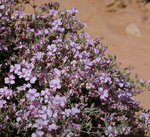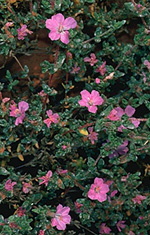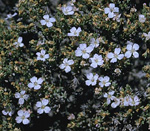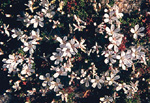 |
This is a small family distributed in warm-temperate, especially dry areas of the Mediterranean, South Africa, South America and Australia, where it is most species-rich. In Australia only the genus Frankenia occurs, members of which are specialised halophiles (salt-loving plants) that can grow in dry, inhospitable places such as the edge of the salt crust of Lake Eyre. They occur throughout the southern arid region of Australia, from Shark Bay to the Victorian Mallee.
Characteristic features of the family Frankeniaceae in Australia include: - small, usually dense shrubs, often sprawling, with small leaves frequently borne in clusters (fascicles), opposite and usually with more or less sheathing bases, often covered with prominent salt glands and encrusted in salt
- flowers regular, white to pale pink, with a tubular calyx and 4-7 free, clawed petals each with a scale on the inner surface
- ovary superior, developing into a capsule surrounded by the persistent calyx
Description
Evergreen shrubs or perennial, rarely annual, terrestrial herbs. Perennating by taproots. Vegetative reproduction by adventitious roots. Internal secretions not obvious. Plants with simple, non-glandular hairs. Leaves opposite, or apparently whorled, or clustered, cauline if herbs, petiolate, subsessile or sessile. Stipules absent or apparently present, interpetiolar, scale-like or membranous, green and leafy or bristle-like, persistent. Lamina simple, symmetric, filiform, acicular, subulate, linear, lanceolate, ovate, elliptic, oblanceolate, ovate, oblong or orbicular; margins entire, ±flat, revolute or recurved; one-veined, with the midrib conspicuous or inconspicuous, and the tertiary venation not reticulate; surfaces pellucid-punctate or not punctate; herbaceous, leathery or succulent. All the flowers bisexual. Inflorescences terminal or axillary, consisting of glomerules, spikes, cymes or solitary flowers. Bracts and bracteoles present. Flowers odourless, ?sessile or stalked. Floral disc present; nectaries absent. Perianth regular, of 2 dissimilar whorls. Calyx segments fused, with 4–7 lobes, valvate in bud; calyx tubular, herbaceous. Corolla segments free, with 4–7 petals, opposite the calyx segments, imbricate, plicate or crumpled in bud, white or blue, without contrasting markings, membranous; claws present; lobes ±entire. Fertile stamens (3–) 4–7 (–24), not clearly correlated with the calyx lobes, free or at least partly fused to the corolla, free of the ovary and style, distinct from each other or fused by their filaments into an open or closed tube, all ±equal. Anthers dorsifixed, versatile or not versatile, opening outwards or sideways by longitudinal slits, 2-celled. Ovary superior and sessile. Carpels 2–5, fused; ovary with 1 locule. Style terminal, single and branched above. Ovules 1–numerous, stalked; placentation basal or parietal. Fruit a dry, dehiscent loculicidal capsule; the perianth on the maturing fruit deciduous, dry and persistent or growing larger. Disseminule micro-surface ±smooth, papillate, reticulate or rugulose, cream, yellow or brown, glossy or dull. Seeds 1–numerous per fruit. Aril absent. Cotyledons 2. Embryo straight.
(Note: this description has been generated from the coded data compiled for the key. Any errors in the key data will be reflected in the descriptions.)
A treatment of the family Frankeniaceae has been published in:
Flora of Australia 8: 112-146.
Australian genera of Frankeniaceae (as recognised for the Flora of Australia)
† = some species native, others introduced
†Frankenia

|
  |

Frankenia connata (flowers)
Photo: P.Ollerenshaw © ANBG

Frankenia cordata (flowers)
Photo: A.Urban © A.Urban

Frankenia densa (flowers)
Photo: J.Wrigley © ANBG

Frankenia drummondii (flowers)
Photo: A.S.George © A.S.George

|
 |
|